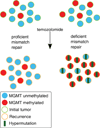Evolution of DNA repair defects during malignant progression of low-grade gliomas after temozolomide treatment
- PMID: 25724300
- PMCID: PMC4482618
- DOI: 10.1007/s00401-015-1403-6
Evolution of DNA repair defects during malignant progression of low-grade gliomas after temozolomide treatment
Abstract
Temozolomide (TMZ) increases the overall survival of patients with glioblastoma (GBM), but its role in the clinical management of diffuse low-grade gliomas (LGG) is still being defined. DNA hypermethylation of the O (6) -methylguanine-DNA methyltransferase (MGMT) promoter is associated with an improved response to TMZ treatment, while inactivation of the DNA mismatch repair (MMR) pathway is associated with therapeutic resistance and TMZ-induced mutagenesis. We previously demonstrated that TMZ treatment of LGG induces driver mutations in the RB and AKT-mTOR pathways, which may drive malignant progression to secondary GBM. To better understand the mechanisms underlying TMZ-induced mutagenesis and malignant progression, we explored the evolution of MGMT methylation and genetic alterations affecting MMR genes in a cohort of 34 treatment-naïve LGGs and their recurrences. Recurrences with TMZ-associated hypermutation had increased MGMT methylation compared to their untreated initial tumors and higher overall MGMT methylation compared to TMZ-treated non-hypermutated recurrences. A TMZ-associated mutation in one or more MMR genes was observed in five out of six TMZ-treated hypermutated recurrences. In two cases, pre-existing heterozygous deletions encompassing MGMT, or an MMR gene, were followed by TMZ-associated mutations in one of the genes of interest. These results suggest that tumor cells with methylated MGMT may undergo positive selection during TMZ treatment in the context of MMR deficiency.
Conflict of interest statement
The authors declare that they have no conflict of interest.
Figures




References
-
- Bady P, Sciuscio D, Diserens AC, Bloch J, van den Bent MJ, Marosi C, Dietrich PY, Weller M, Mariani L, Heppner FL, Mcdonald DR, Lacombe D, Stupp R, Delorenzi M, Hegi ME. MGMT methylation analysis of glioblastoma on the Infinium methylation BeadChip identifies two distinct CpG regions associated with gene silencing and outcome, yielding a prediction model for comparisons across datasets, tumor grades, and CIMP-status. Acta Neuropathol. 2012;124:547–560. - PMC - PubMed
-
- Baumert B, Mason WP, Ryan G, Bromberg JE, van den Bent M, Hoang-Xuan K, Brandes AA, Kantor G, Taphoorn MJ, Ben Hassel M, Rees J, Wick W, von DA, Hartmann C, Kros JM, Hegi ME, Dif N, Lacombe D, Gorlia T, Stupp R. The international EORTC/NCIC-CTG/TROG/MRC-CTU low-grade glioma trial: Temozolomide chemotherapy vs. radiotherapy in molecularly characterized (1p loss) LGG. Neuro Oncol. 2013;15
-
- Beroukhim R, Getz G, Nghiemphu L, Barretina J, Hsueh T, Linhart D, Vivanco I, Lee JC, Huang JH, Alexander S, Du J, Kau T, Thomas RK, Shah K, Soto H, Perner S, Prensner J, Debiasi RM, Demichelis F, Hatton C, Rubin MA, Garraway LA, Nelson SF, Liau L, Mischel PS, Cloughesy TF, Meyerson M, Golub TA, Lander ES, Mellinghoff IK, Sellers WR. Assessing the significance of chromosomal aberrations in cancer: methodology and application to glioma. Proc Natl Acad Sci U S A. 2007;104:20007–20012. - PMC - PubMed
-
- Bodell WJ, Gaikwad NW, Miller D, Berger MS. Formation of DNA adducts and induction of lacI mutations in Big Blue Rat-2 cells treated with temozolomide: implications for the treatment of low-grade adult and pediatric brain tumors. Cancer Epidemiol Biomarkers Prev. 2003;12:545–551. - PubMed
Publication types
MeSH terms
Substances
Grants and funding
LinkOut - more resources
Full Text Sources
Other Literature Sources
Medical
Molecular Biology Databases
Research Materials
Miscellaneous

